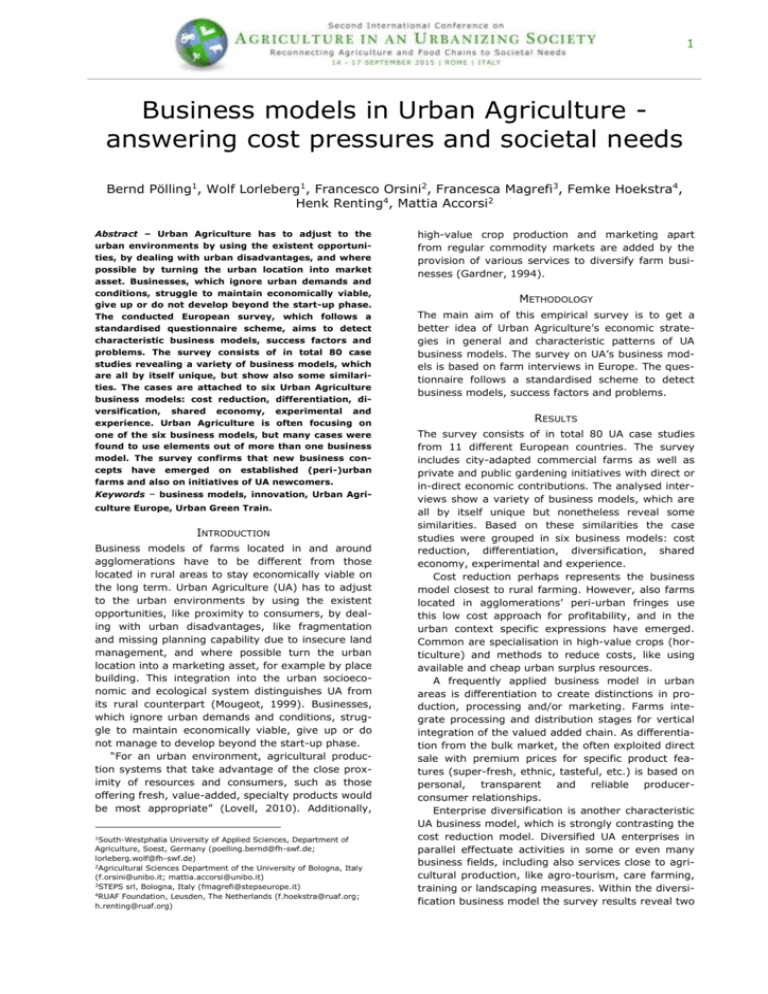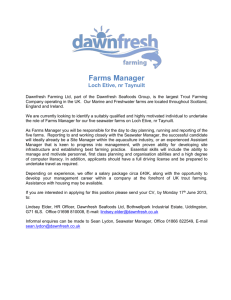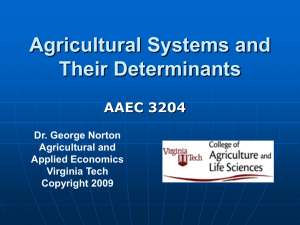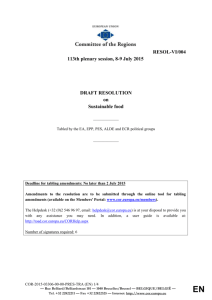245_UGT COST_BM UA_Paper_AgUrbanSociety_10072015
advertisement

1 Business models in Urban Agriculture answering cost pressures and societal needs Bernd Pölling1, Wolf Lorleberg1, Francesco Orsini2, Francesca Magrefi3, Femke Hoekstra4, Henk Renting4, Mattia Accorsi2 Abstract – Urban Agriculture has to adjust to the urban environments by using the existent opportunities, by dealing with urban disadvantages, and where possible by turning the urban location into market asset. Businesses, which ignore urban demands and conditions, struggle to maintain economically viable, give up or do not develop beyond the start-up phase. The conducted European survey, which follows a standardised questionnaire scheme, aims to detect characteristic business models, success factors and problems. The survey consists of in total 80 case studies revealing a variety of business models, which are all by itself unique, but show also some similarities. The cases are attached to six Urban Agriculture business models: cost reduction, differentiation, diversification, shared economy, experimental and experience. Urban Agriculture is often focusing on one of the six business models, but many cases were found to use elements out of more than one business model. The survey confirms that new business concepts have emerged on established (peri-)urban farms and also on initiatives of UA newcomers. 1 Keywords – business models, innovation, Urban Agriculture Europe, Urban Green Train. INTRODUCTION Business models of farms located in and around agglomerations have to be different from those located in rural areas to stay economically viable on the long term. Urban Agriculture (UA) has to adjust to the urban environments by using the existent opportunities, like proximity to consumers, by dealing with urban disadvantages, like fragmentation and missing planning capability due to insecure land management, and where possible turn the urban location into a marketing asset, for example by place building. This integration into the urban socioeconomic and ecological system distinguishes UA from its rural counterpart (Mougeot, 1999). Businesses, which ignore urban demands and conditions, struggle to maintain economically viable, give up or do not manage to develop beyond the start-up phase. “For an urban environment, agricultural production systems that take advantage of the close proximity of resources and consumers, such as those offering fresh, value-added, specialty products would be most appropriate” (Lovell, 2010). Additionally, South-Westphalia University of Applied Sciences, Department of Agriculture, Soest, Germany (poelling.bernd@fh-swf.de; lorleberg.wolf@fh-swf.de) 2 Agricultural Sciences Department of the University of Bologna, Italy (f.orsini@unibo.it; mattia.accorsi@unibo.it) 3 STEPS srl, Bologna, Italy (fmagrefi@stepseurope.it) 4 RUAF Foundation, Leusden, The Netherlands (f.hoekstra@ruaf.org; h.renting@ruaf.org) 1 high-value crop production and marketing apart from regular commodity markets are added by the provision of various services to diversify farm businesses (Gardner, 1994). METHODOLOGY The main aim of this empirical survey is to get a better idea of Urban Agriculture’s economic strategies in general and characteristic patterns of UA business models. The survey on UA’s business models is based on farm interviews in Europe. The questionnaire follows a standardised scheme to detect business models, success factors and problems. RESULTS The survey consists of in total 80 UA case studies from 11 different European countries. The survey includes city-adapted commercial farms as well as private and public gardening initiatives with direct or in-direct economic contributions. The analysed interviews show a variety of business models, which are all by itself unique but nonetheless reveal some similarities. Based on these similarities the case studies were grouped in six business models: cost reduction, differentiation, diversification, shared economy, experimental and experience. Cost reduction perhaps represents the business model closest to rural farming. However, also farms located in agglomerations’ peri-urban fringes use this low cost approach for profitability, and in the urban context specific expressions have emerged. Common are specialisation in high-value crops (horticulture) and methods to reduce costs, like using available and cheap urban surplus resources. A frequently applied business model in urban areas is differentiation to create distinctions in production, processing and/or marketing. Farms integrate processing and distribution stages for vertical integration of the valued added chain. As differentiation from the bulk market, the often exploited direct sale with premium prices for specific product features (super-fresh, ethnic, tasteful, etc.) is based on personal, transparent and reliable producerconsumer relationships. Enterprise diversification is another characteristic UA business model, which is strongly contrasting the cost reduction model. Diversified UA enterprises in parallel effectuate activities in some or even many business fields, including also services close to agricultural production, like agro-tourism, care farming, training or landscaping measures. Within the diversification business model the survey results reveal two 2 perspectives: Firstly, rather many urban farms diversify their business into new – often serviceoriented – fields and secondly, non-agricultural enterprises which step into farming as newcomers, e. g. social care institutions, which use agriculture to diversify their businesses. Experimental UA is based on initiatives that explicitly integrate technological innovation processes that are suited to respond to urban contextual settings. Innovation may be in production (e. g. aquaponic systems or artificial lighting for indoor cultivation), but also in the processing (e. g. recycle of the urban waste products), or in the functions (e.g. revitalisation of urban brownfields). An important characteristic is also that technologies often are still in development and the applied ‘vanguard’ technology can even be part of the marketing. As an expression of the new economy, since a few years initiatives based on ‘shared economy’ increasingly gain importance. Required resources to run UA in the form of a shared economy model, e. g. CSA, are jointly mobilised and managed, including land, labour, credit, tools, machinery, network contacts and knowledge. Experience represents the sixth business model that was distinguished on the basis of interviews. This model focuses on providing authentic and ‘memorable’ experiences by selling rather a story (experience) than only a product. Place-making and training or leisure activities (for example gastronomic experiences) are important elements that in this model are combined with food production. These six UA business models address the special urban conditions by making use of the advantage of nearby costumers, by compensating negative urban influences, and in some cases also by valorising specific urban contexts such as strong social networks and generating social and ecological benefits (van der Schans et al., 2014). Although UA is often focusing on a specific business model, many cases were found using elements out of more than one. DISCUSSION While economies of scale is still an important ‘rural’ business model in farming to stay competitive under intense cost pressures in the food sector, UA business models have to distinguish by adjusting to specific urban contexts and move away from mainstream commodity market and global prices mechanisms. The conducted European survey confirms that new business concepts have emerged on established (peri-)urban farms and also by initiatives of newcomers in UA. The specific challenging, but also enabling urban conditions encourage innovations in farming, and result in the appearance of business models that in many respects are different from rural farms. Product differentiation and enterprise diversification are the prevailing business models within this survey, but new forms of and new actors in UA raise experimental, shared economy and experience to newly emerging business models. Business model classification supports the investigation and learning of UA developments. On the one hand, the survey identifies farms, which adapt to the cities in different ways. The term UA means for them “a fundamental re-orientation from the rural towards the urban environment” (van der Schans, 2010). On the other hand, however, UA initiatives are also increasingly driven by newcomers and interest groups outside farming. For example care institutions, housing companies or start-up businesses; some step in from another profession into farming for business diversification reasons, while others start non-commercially or out of social considerations. Often they bring in new business ideas, competences and networks, and the implications of these and differences from ’rural’ business models still are insufficiently understood. CONCLUSION The observable growth and differentiation of business models in UA clearly reflects the evolution the sector is experiencing. As many of these experiences develop spontaneously in the most diverse and geographically distant urban environments across Europe, the study of their success factors, bottlenecks and specific training and policy requirements may guide current and future entrepreneurs in their project and organizational choices. ACKNOWLEDGEMENTS The interviews were carried out by members and supporters of EU-funded COST-Action “Urban Agriculture Europe” and Erasmus+ project “Urban Green Train” (URBAN GRreen Education for ENTeRprising Agricultural INnovation). REFERENCES Gardner, B.L. (1994). Commercial Agriculture in Metropolitan Areas: Economics and Regulatory Issues. Agricultural and Resource Economics Review23(1):100-109. Lovell, S.T. (2010). Multifunctional Urban Agriculture for Sustainable Land Use Planning in the United States. Sustainability2010(2): 2499-2522. Mougeot, L.J.A. (1999). Urban Agriculture: definition, presence, potentials and risks, and policy challenges. Cities Feeding People Series Report31. Renting, H., Hoekstra, F. and Dubbeling, M. (2015). State-of-art of UA entrepreneurship: Comparative analysis of business opportunities. Final Report O1A1 Erasmus+ project URBAN GReen Education for ENTteRprising Agricultural Innovation. Thebo, A.L., Drechsel, P. and Lambin, E.F. (2014). Global assessment of urban and peri-urban agriculture: irrigated and rainfed croplands. Environmental Research Letters(9)114002. van der Schans, J.-W. (2010). Urban Agriculture in the Netherlands. Urban Agriculture magazine(24): 40-42. van der Schans, J.-W., Renting, H. and van Veenhuizen, R. (2014). Urban Agriculture and Innovation. Urban Agriculture magazine(28):3-10.







